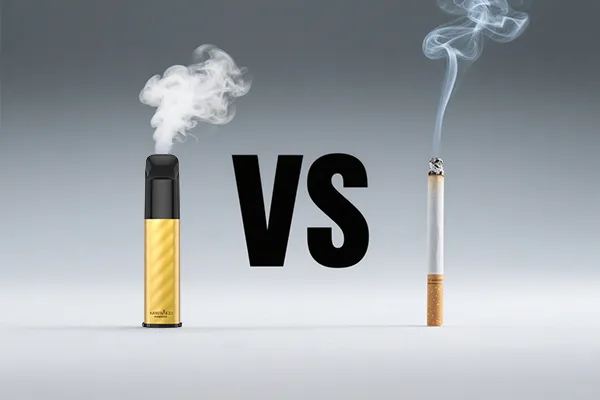You can master the latest information, new product , exhibition, promotion, etc
In the ever-evolving landscape of tobacco consumption, a significant battle is underway—a showdown between e-cigarettes and traditional cigarettes, marking what many consider a health revolution. As concerns about the health impacts of smoking continue to grow globally, understanding the differences between these two forms of nicotine delivery is crucial for both consumers and the tobacco industry. This article delves deep into the various aspects of this health revolution, exploring how e-cigarettes and traditional cigarettes stack up against each other in terms of health risks, ingredients, and more.
Health Impacts: A Clear Divide
One of the most critical aspects of the e-cigarette vs. traditional cigarette debate is their respective health impacts. Traditional cigarettes have long been associated with a plethora of severe health issues. The combustion process in traditional cigarettes releases over 7,000 chemicals, many of which are toxic and carcinogenic. These chemicals include tar, carbon monoxide, and formaldehyde, among others. Regular smoking of traditional cigarettes significantly increases the risk of developing lung cancer, heart disease, respiratory diseases, and various other life-threatening conditions. According to the World Health Organization (WHO), tobacco smoking is responsible for the deaths of approximately 8 million people each year, making it one of the leading causes of preventable death globally.
On the other hand, e-cigarettes operate on a different principle. Instead of combustion, e-cigarettes heat a liquid, usually containing nicotine, flavorings, and other chemicals, to create an aerosol that users inhale. Since there is no combustion, e-cigarettes do not produce tar or many of the harmful by-products associated with traditional cigarettes. While the long-term health effects of e-cigarette use are still being studied, current research suggests that they are significantly less harmful than traditional cigarettes. Public Health England has stated that e-cigarettes are around 95% less harmful than traditional tobacco products. However, it's important to note that e-cigarettes are not risk-free, and their use can still have negative impacts on health, especially if they contain harmful substances or are used inappropriately.
Ingredients: Unveiling the Differences
The ingredients in e-cigarettes and traditional cigarettes also vary greatly, contributing to their different health profiles. Traditional cigarettes contain a complex mixture of chemicals, many of which are added during the manufacturing process to enhance flavor, increase shelf life, or improve burn characteristics. Tobacco leaves are treated with various additives, including sugars, humectants, and chemicals to make the smoke more palatable. When burned, these additives can react to form new and potentially more harmful substances.
E-cigarette liquids, on the other hand, typically have a simpler ingredient composition. The primary components of e-liquids are propylene glycol, vegetable glycerin, nicotine, and flavorings. Propylene glycol and vegetable glycerin are used as the base to carry the nicotine and flavorings and create the aerosol. While propylene glycol and vegetable glycerin are generally recognized as safe for ingestion by the U.S. Food and Drug Administration (FDA), inhaling them in aerosol form may have different effects on the lungs, and more research is needed to fully understand the long-term implications. Nicotine, although addictive, is not the primary cause of the severe health problems associated with traditional smoking. The flavorings used in e-cigarettes can range from fruit and candy flavors to more traditional tobacco flavors, and their safety also depends on the quality and type of flavoring agents used.

Market Trends and Consumer Preferences
The battle between e-cigarettes and traditional cigarettes is also reflected in the market trends and consumer preferences. In recent years, the global e-cigarette market has experienced rapid growth. As more consumers become aware of the health risks associated with traditional cigarettes and seek alternatives, the demand for e-cigarettes has soared. E-cigarettes offer consumers a potentially less harmful way to satisfy their nicotine cravings, and their customizable nature, with options for different nicotine strengths and a wide variety of flavors, appeals to a broad range of users.
However, traditional cigarettes still hold a significant share of the market, especially in regions where awareness of the benefits of e-cigarettes is low or where there are strict regulations limiting the availability and promotion of e-cigarettes. Additionally, the tobacco industry has a long history and established distribution networks, which make it difficult for e-cigarettes to completely replace traditional cigarettes overnight. Nevertheless, the trend seems to be shifting in favor of e-cigarettes as more countries and regions implement policies to reduce tobacco consumption and promote harm reduction strategies.
Regulatory Landscape: A Key Factor
The regulatory landscape plays a crucial role in the competition between e-cigarettes and traditional cigarettes. Traditional cigarettes are subject to extensive regulations in many countries, including restrictions on advertising, packaging warnings, and taxes. In contrast, the regulation of e-cigarettes is still evolving. Some countries have imposed strict regulations on e-cigarettes, treating them similar to traditional tobacco products, while others have taken a ity, affordability, and marketing of both e-cigarettes and traditional cigarettes. For example, high taxes on traditional cigarettemore lenient approach, recognizing their potential as a harm reduction tool.
Regulatory decisions can significantly impact the availabils can make them more expensive, encouraging consumers to switch to cheaper alternatives like e-cigarettes. On the other hand, strict regulations on e-cigarettes, such as banning certain flavors or limiting nicotine strengths, can reduce their appeal to consumers. Striking the right balance in regulation is essential to ensure public health while also allowing for innovation and harm reduction in the tobacco and nicotine product market.
In conclusion, the showdown between e-cigarettes and traditional cigarettes represents a significant health revolution. While e-cigarettes offer a potentially less harmful alternative to traditional cigarettes, both forms of nicotine delivery have their own set of risks and considerations. As research continues to advance and regulatory policies evolve, it's important for consumers to stay informed and make educated decisions about their nicotine consumption. The future of this health revolution remains uncertain, but one thing is clear: the battle between e-cigarettes and traditional cigarettes will continue to shape the landscape of tobacco and nicotine use for years to come.








